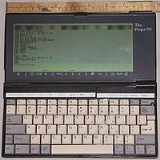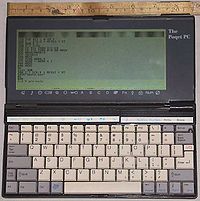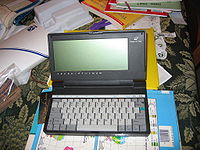
Poqet PC
Encyclopedia

Portable computer
A portable computer is a computer that is designed to be moved from one place to another and includes a display and keyboard. Portable computers, by their nature, are generally microcomputers. Portable computers, because of their size, are also commonly known as 'Lunchbox' or 'Luggable' computers...
IBM PC compatible
IBM PC compatible
IBM PC compatible computers are those generally similar to the original IBM PC, XT, and AT. Such computers used to be referred to as PC clones, or IBM clones since they almost exactly duplicated all the significant features of the PC architecture, facilitated by various manufacturers' ability to...
computer
Computer
A computer is a programmable machine designed to sequentially and automatically carry out a sequence of arithmetic or logical operations. The particular sequence of operations can be changed readily, allowing the computer to solve more than one kind of problem...
, introduced in 1989 by Poqet Computer Corporation with a price of $2000. The computer was discontinued after Fujitsu Ltd. bought Poqet Computer Corp. It was the first subnotebook
Subnotebook
A subnotebook is a class of laptop computers that are smaller and lighter than a typical laptop....
form factor IBM-PC compatible computer that ran MS-DOS
MS-DOS
MS-DOS is an operating system for x86-based personal computers. It was the most commonly used member of the DOS family of operating systems, and was the main operating system for IBM PC compatible personal computers during the 1980s to the mid 1990s, until it was gradually superseded by operating...
. The Poqet PC is powered by two AA-size batteries. Through the use of aggressive power management
Power management
Power management is a feature of some electrical appliances, especially copiers, computers and computer peripherals such as monitors and printers, that turns off the power or switches the system to a low-power state when inactive. In computing this is known as PC power management and is built...
, which includes stopping the CPU
Central processing unit
The central processing unit is the portion of a computer system that carries out the instructions of a computer program, to perform the basic arithmetical, logical, and input/output operations of the system. The CPU plays a role somewhat analogous to the brain in the computer. The term has been in...
between keystrokes, the batteries are able to power the computer for anywhere between a couple of weeks and a couple of months, depending on usage. The computer also uses an "instant on" feature, such that after powering it down, it can be used again immediately without having to go through a full booting sequence. The Poqet PC is comparable to the HP 95LX
HP 95LX
The HP 95LX was the first MS-DOS pocket computer or personal digital assistant, introduced by Hewlett-Packard in April 1991 in collaboration with Lotus Development Corporation....
/HP 100LX/HP 200LX
HP 200Lx
The HP 200LX is a personal digital assistant introduced by Hewlett-Packard in 1994. It was often called a palmtop computer, and it was notable that it was, with some minor exceptions, a MS-DOS-compatible computer in a palmtop format, complete with a monochrome graphic display, QWERTY keyboard,...
and the Atari Portfolio
Atari Portfolio
The Atari Portfolio is the first PC-compatible palmtop computer, and was released by Atari Corporation in 1989. The Portfolio was licenced from Distributed Information Processing based in Guildford, Surrey, UK...
handheld computers.
Poqet PC, "Classic" and Prime
Three variants were produced. The Poqet PC was the first to be introduced and the Poqet PC Prime followed shortly after. (The original version was subsequently renamed the Poqet PC "Classic"). Several years later, the Poqet PC Plus was introduced. The main difference between the Poqet PC Classic and the Prime was the expansion of RAM from 512 to 640 KBKilobyte
The kilobyte is a multiple of the unit byte for digital information. Although the prefix kilo- means 1000, the term kilobyte and symbol KB have historically been used to refer to either 1024 bytes or 1000 bytes, dependent upon context, in the fields of computer science and information...
and enhancement of the power management features.
Specifications
- Size: 8.8 in (223.5 mm) x 4.3 in (109.2 mm) x 1 in (25.4 mm)
- Weight: 1.2 lb (0.544310844 kg) w/batteries
- Battery life: 50-100 hours (But expect a lot less if running long, cpu-intensive programs(10-20h approx))
- Microprocessor: 80C88 / 7 MHz
- Memory: 640 KB SRAM
- Display: Reflective DSTN (no backlight)
- Display compatibility: MDA: 80 × 25 characters
CGA: 640 × 200 pixels - PCMCIA: 2 × Type I, Revision 1.0 memory card slots
- Secondary storage: Drive A: 512 KB-2 MB PCMCIA (not included)
Drive B: 512-2 MB PCMCIA (not included)
Drive C: 768 KB ROM drive with MS-DOS 3.3 and PoqetTools
Drive D: 22 KB volatile RAM drive - Built-in software: MS-DOS 3.3, PoqetLink, and PoqetTools
Poqet PC Plus

Fujitsu
is a Japanese multinational information technology equipment and services company headquartered in Tokyo, Japan. It is the world's third-largest IT services provider measured by revenues....
purchased Poqet Computer Corp., the new and improved Poqet PC Plus was introduced. The Poqet PC Plus had significant differences from the Classic and Prime models, some better than others. It features a rechargeable battery pack that holds a smaller charge than the "Classic", enhanced PC Card
PC Card
In computing, PC Card is the form factor of a peripheral interface designed for laptop computers. The PC Card standard was defined and developed by the Personal Computer Memory Card International Association which itself was created by a number of computer industry companies in the United States...
slots that now support more PC Cards, a transflective backlit LCD and 2 MB of RAM (640 KB to DOS, 64 KB shadow, and 1-1344 KB for a RAM disk). The Poqet "Classic"'s LCD didn't have a backlight and was more prone to breaking than the Poqet PC Plus. It also only took Type I, Release 1.0 SRAM cards, as opposed to Type II cards and Release 2.0 cards, including flash, SRAM, and a few modem cards. The Plus also had more memory. Despite many improvements, the Plus also had its drawbacks. The Poqet PC Plus was considerably larger and heavier than its predecessors. It weighed approximately 1.83 lb (0.8300740371 kg) as opposed to the Classic's 1.2 lb (0.544310844 kg). It also has a very odd miniature 26-pin serial connector for which there is no currently available adapter. However, many Toshiba
Toshiba
is a multinational electronics and electrical equipment corporation headquartered in Tokyo, Japan. It is a diversified manufacturer and marketer of electrical products, spanning information & communications equipment and systems, Internet-based solutions and services, electronic components and...
external floppy drives and dongles used this same JAE connector. An amateur radio hobbyist who uses a Poqet has found a way to make a suitable adapter. It also is not totally PCMCIA Release 2.0 compatible, so not all memory cards will work, and, as Bryan Mason says on his Poqet site, only the "PNB Samantha modem, Megahertz 14.4 kbit/s modem with XJACK, and the AT&T Paradyne KeepInTouch 14.4 kbit/s modems" will work in it. In addition, not all CompactFlash cards work in the Poqet. Users have found that many machines do not work with newer CF cards.
Specifications
- Size: 9.05 in (229.9 mm) x 5.12 in (130 mm) x 1.42 in (36.1 mm)
- Weight: 1.54 lb (0.6985322498 kg) w/batteries
- Battery life: 3-12 hours (application dependent)
- Microprocessor: NEC V30 at 16 MHz
- Memory: 2 MB (Memory above 640 KB is configurable as EMS or a RAM disk. 64 KB reserved is for BIOS shadow.)
- Display:Transflective LCD with backlight on demand. 7.25 in (184.2 mm) diagonal size.
- Display compatibility: MDA: 80 x 25 characters
CGA: 640 x 200 pixels - Expansion: 2 × Type II PCMCIA slots (nearly compatible with PCMCIA Revision 2.0.)
1 × TTL serial port
1 × TTL/RS-232 serial port (configurable)- PCMCIA Compatibility: Supports SunDisk (SanDisk) ATA Flash, 3.3 V and 5 V SRAM, AT&T Paradyne KeepInTouch modem, Megahertz PCMCIA 14.4 kbit/s modem with XJACK, and PNB Samantha modem.
- Secondary storage: Drive A: Left PCMCIA slot
Drive B: Right PCMCIA slot
Drive C: ROM drive with MS-DOS 5.0
Drive D: 784 KB Flash drive
Drive E: RAM drive (if configured) - Built-in software: MS-DOS 5.0, EMS driver, RAM Disk driver, Flash utility, barcode reader, PenConnect serial communications software, PCMCIA driver
Conclusion
The Poqet PC was one of the first subnotebooks to exist in the marketplace, and still today is one of the smallest, although it is beaten by the HP 200LXHP 200Lx
The HP 200LX is a personal digital assistant introduced by Hewlett-Packard in 1994. It was often called a palmtop computer, and it was notable that it was, with some minor exceptions, a MS-DOS-compatible computer in a palmtop format, complete with a monochrome graphic display, QWERTY keyboard,...
. It was immediately recognized as a milestone in portable computing when PC Magazine
PC Magazine
PC Magazine is a computer magazine published by Ziff Davis Publishing Holdings Inc. A print edition was published from 1982 to January 2009...
awarded the Poqet PC development team (Ian Cullimore
Ian Cullimore
Ian Cullimore is an English-born mathematician and computer scientist who has been influential in the pocket PC arena.-Biography:Cullimore has a degree in Mathematics from King's College London, and a PhD in Cognitive and Computer Science from the University of Sussex.He was the original founder ...
, John Fairbanks, Leroy Harper, Shinpei Ichikawa, Stav Prodromou
Stav Prodromou
Stavro Evangelo "Stav" Prodromou is a Greek American businessman, and the founder and former chief executive officer of Poqet Computer Corporation...
) its coveted Technical Excellence Award for 1989. Interestingly, the same device that PC World called "one of the 50 greatest gadgets of the last 50 years" had a very short lifespan, from only about 1989-1994. After Poqet was bought by Fujitsu, the Poqet was soon axed. For a short time Poqet value declined, with the onset of Windows CE
Windows CE
Microsoft Windows CE is an operating system developed by Microsoft for embedded systems. Windows CE is a distinct operating system and kernel, rather than a trimmed-down version of desktop Windows...
. A similar decline in HP 200LX demand also occurred after the introduction of HP Windows CE machines. However, despite the new machines' power, their operating system soon proved to be inefficient. The Poqets and HP 'LX' DOS machines became very high in demand, and recently an HP 200LX sold for $182 on eBay. Poqets also are in fairly high demand, but fetch somewhat lower prices. A Cherry Hill, NJ business, Disks 'n' Data, once had a stock of Classics and Pluses. As the owner of the store, Jerry Tessler, put it: "I sold them all in twenty minutes." Unlike running WinCE, running DOS in near-standard specifications meant that everything from Lotus 1-2-3 to Zork worked as expected.
See also
- HP 95LXHP 95LXThe HP 95LX was the first MS-DOS pocket computer or personal digital assistant, introduced by Hewlett-Packard in April 1991 in collaboration with Lotus Development Corporation....
- HP 100LX
- HP 200LXHP 200LxThe HP 200LX is a personal digital assistant introduced by Hewlett-Packard in 1994. It was often called a palmtop computer, and it was notable that it was, with some minor exceptions, a MS-DOS-compatible computer in a palmtop format, complete with a monochrome graphic display, QWERTY keyboard,...
- HP 1000CX
- SubnotebookSubnotebookA subnotebook is a class of laptop computers that are smaller and lighter than a typical laptop....
- Atari PortfolioAtari PortfolioThe Atari Portfolio is the first PC-compatible palmtop computer, and was released by Atari Corporation in 1989. The Portfolio was licenced from Distributed Information Processing based in Guildford, Surrey, UK...
- MS-DOSMS-DOSMS-DOS is an operating system for x86-based personal computers. It was the most commonly used member of the DOS family of operating systems, and was the main operating system for IBM PC compatible personal computers during the 1980s to the mid 1990s, until it was gradually superseded by operating...
- FujitsuFujitsuis a Japanese multinational information technology equipment and services company headquartered in Tokyo, Japan. It is the world's third-largest IT services provider measured by revenues....
- LifebookLifebookLIFEBOOK is line of laptop computers made by Fujitsu.Within the LIFEBOOK family, Fujitsu offers a range of thin and light, portable, and desktop-alternative notebooks, as well as convertible and Tablet PCs.-History:...
- Zeos Pocket PCZeosZEOS [ZEOS International, Ltd.] is a PC manufacturer based in Minneapolis, Minnesota. Originally based in New Brighton, Minnesota and founded by Gregory E. Herrick, the company incorporated in Minnesota in 1981. Prior to manufacturing PCs, the company was called NPC Electronics. NPC was a contract...
Sources
- California Digital. 2006. December 22, 2006.
- Mason, Bryan. The Poqet PC Home Page. 2006. December 25, 2006.
- Poqet PC Plus Serial Adapter. 2005. December 22, 2006.
- Tynan, Dan. "The 50 Greatest Gadgets of the Past 50 Years." PC World. 2005. December 25, 2006.
- Wong, Al. Al's Review of Fujitsu's Poqet PC Plus. 2001. December 23, 2006.
External links
- The Poqet PC Home Page A collection of Poqet information, along with documentation, software downloads, and FAQs.
- A Poqet PC Wiki is a wiki about the Poqet PC that is currently under construction.
- Fujitsu's Home Page The company that eventually sold Poqets later on in the series' short lifespan.
- Poqet PC ... QRPer's field computing dream! A page on the Poqet used for ham radio. Lots of links and info.
- Poqet PC Plus Serial Adapter Making a Poqet PC Plus serial adapter.
- California Digital sells Poqet PC Pluses and accessories.
- Poqet PC A review of the Classic by Tom Carlson.
- PC World - The 50 Greatest Gadgets of the Past 50 Years mentions the Poqet computer in a part of its article
- PC Magazine also mentioned the Poqet PC in this article
- New York Times May 14, 1989 "The Big News in Tiny Computers" by John MarkoffJohn MarkoffJohn Markoff is a journalist best known for his work at The New York Times, and a book and series of articles about the 1990s pursuit and capture of hacker Kevin Mitnick.- Biography :...

